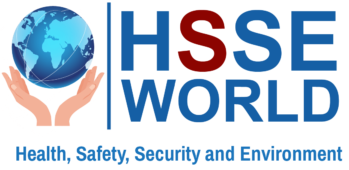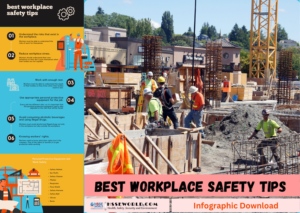Photo of the day: How to Avoid the Fatal Four
In the construction industry, certain hazards are present every day on the job site.
The Occupational Safety & Health Administration (OSHA) has identified the four leading causes of fatalities in the construction industry – known as OSHA’s “Fatal Four Hazards” or “Construction Focus Four Hazards”.
The Fatal Four Hazards consist of falls, electrical exposure, struck-by, and caught-in/between situations, and result in 545 worker fatalities in the United States every year.

Fall Hazards – how-to-choose-your-fall-protection-anchorage
Falls are the number one killer of construction workers on the job.
The different heights at which fall protection is required are:
- 6 feet – General fall protection
- 10 feet – Scaffolds
- 15 to 30 feet – Steel erection
If a worker is performing a job above one of the heights mentioned above, one of these systems must be in place:
- Guardrail Systems
- Covers
- Personal Fall Arrest (PFA) systems
Make sure to identify fall hazards such as holes in platforms and unguarded edges before work begins.
Electrocutions
One of the top ten most cited OSHA standards; electrocutions are the second deadliest fatal four construction hazards. That’s why OSHA has a specific regulatory standard for safety training and electrical work.
Here are some safe work practices for live electrical work on the Jobsite:
- Locate and identify utilities before starting work.
- Look for overhead power lines when operating any equipment.
- Maintain a safe distance away from power lines.
- Do not operate portable electric tools unless they are grounded or double insulated.
- Use ground-fault surge protectors.
- Be alert to electrical hazards when working with ladders, scaffolds, or other platforms.
Struck-By Object/Hazard
A struck-by hazard is anything at a worksite that could produce injuries by forcible contact or impact between the injured person and an object or piece of equipment.
The difficulty with protecting workers from flying objects is that they may not be participating in the work that causes the object to fly.
Workers need to make sure coworkers follow the safety rules outlined by OSHA and the employer, and wear appropriate personal protective equipment (PPE) for the worksite.
There are four Struck-by hazard categories:
- Flying object
- Falling object
- Swinging object
- Rolling object
OSHA requires employers to protect workers from struck-by hazards. Employers are required to:
- Meet all heavy equipment, motor vehicle, and general requirements included in OSHA standards
- Provide proper PPE, like wearing high-visibility clothes near equipment/vehicles.
- Provide required training for equipment and vehicles
- Ensure qualification of operators, riggers, signal persons, and competent persons
Caught-in/Between
Trench and excavation cave-ins, and workplace accidents where workers are pinned or caught-between machinery or fixed structures, often happen suddenly and without warning.
To avoid being caught in or between objects:
- Never enter an unprotected trench 5 feet or deeper without an adequate protective system in place
- Make sure the trench or excavation is protected either by sloping, shoring, benching, or trench shield systems.
- Never position yourself between moving and fixed objects
Common Sense “Smarts”:
- Always wear the proper personal protective equipment
- Don’t overexert yourself—get help with heavy tasks
- Don’t overextend yourself when on ladders—and risk losing your balance
- Always use the proper tool for the job
- Concentrate on your work
- Look for unsafe acts or unsafe working conditions—and then report them
- Watch out for others—remember you are part of a team
Ask the following questions before you begin to work:
- Are the conditions safe to do the work?
- Are the methods we are going to use safe?
- Does everyone know what to do?
- Does everyone know how to do it?
- Can I fall, get struck by, et caught between or under, or get electrocuted on this job?
Download the photo
More photos:
- Photo of the day: 10 Essential Safety Tips for Driving in Hot Weather Conditions
- Photo of the day: best workplace safety tips
- Photo of the day: The Importance of Stop Work Authority in Maintaining Workplace Safety
- Photo of the day: Tomorrow’s Reward for Working Safely Today: Cultivating a Culture of Safety
- Photo of the day: Preventing slips and trips at work
- Photo of the day: Learn the DRSABCD action Plan
- Working with Electricity Electrical Accidents Guide for Electrical Workers
- Photo of the day: Hearing Protection Device Selection
- Photo of the day: If An Earthquake Shakes You-Infographic free
- Fire Safety Posters Free Download
- Photo of the day: First Aid for Electrical Burns-Infographic free
- Infographic: First Aid for Cuts and Scrapes free download
- Photo of The day: Work Safe with Lasers-Laser Safety free
- Photo of the day: Working Safely with chemicals and chemical Management
- Photo of the day: Safe work practices when using MEWPs ( updated)
- Photo of the day: Preventing Common Kitchen Hazards
- Photo of the day: Safe handling of Gas Cylinders and lecture bottles
- Photo of the day: Forklift Stability Triangle
- Photo of the day: Defective Tools Safe Work Practice
- Photo of the day: Lift With Your Legs Not With Your Back
- Photo of the day: First Aid for burns
- Photo of the day: The 7 Principles of HACCP
- Photo of the day: Working Safely with Suspended Loads
- Photo of the day: Heat Stroke First Aid and safety posters
- Photo of the day: Near-Miss Reporting and Posters
- Photo of the day: Ergonomic chair and office chair safety tips
- Photo of the day: Whole Body Vibration
- Photo of the day: Substation Safety Equipment
- Photo of the day: Bypassing Safety Controls Rules
- Photo of the day: Lightning Safety Tips
- Photo of the day: Overhead Power lines Clearance
- Photo of the day: Floor Marking
- Photo of the day: Types of Foot Protection
- Photo of the day: Types of Hand Protection
- Photo of the day: Lockout and Tagout Safety
- Photo of the day: Fall Protection Plans
- Photo of the day: Flood Safety Tips
- Photo of the day: Read All Labels Work safe
- Photo of the day: Run Project safely with Crane Hand Signals
- Photo of the day: Flagman and Traffic control
- Photo of the day: Managing Risks of Exposure to Solvents in the workplace
- Photo of the day: Scissor Lift Safety
- Photo of the day: HSE Bulletin Board
- Photo of the day: Arc-Fault Circuit Interrupters (AFCI)
- Photo of the day: Safe use of ladders and step ladders
- Photo of the day: Concrete Truck Driver Hand Signals
- Photo of the day: Extension Cord Safety Tips
- Photo of the day: Protect your Head
- Photo of the day: choosing the right Anchorage
- Photo of the day: Work-Related Asthma
- Photo of the day: Top FIVE Heavy Equipment Construction Site Safety Tips
- Photo of the day: sun safety in the workplace
- Photo of the day: Cannabis and Impairment in the Workplace
- Photo of the day: Position for safety and comfort-Safety Tips
- Photo of the day: Generator Safety
- Photo of the day: Controlling COVID-19 in the Workplace-Physical Barriers
- Photo of the day: Manual Material handling
- Photo of the day: Personal Protective Equipment last resort
- Photo of the day: WHMIS 2015 – Pictograms
- Photo of the day: Indoor Air Quality
- Photo of the day: Noise in the affected workplace
- Photo of the day: Fatigue at Work
- Photo of the day: Don’t be Driven to Distraction
- Photo of the day: working in heat and Humidex Rating
- How to use Plate Clamps Safely: Safety Moment#34
- Photo of the day: Sitting at work
- Photo of the day: 5 ways to reduce the risk of Slipping and Tripping
- Photo of the day: Preventing the spread of contagious illness
- Photo of the day: Incident Investigations
- Photo of the day: 10 Scaffold Safety Essentials
- Photo of the day: Effective Health and Safety Committees
- Photo of the day: New worker Orientation & Safety Orientation checklist
- Photo of the day: Workplace Inspection
- Photo of the day: musculoskeletal disorders
- Photo of the day: Emergency preparedness in the workplace
- Photo of the day: Mental health in the workplace
- Photo of the day: Trenching Safety Tips That Can Save a Life
- Photo of the day: Dangerous Goods Classes
- Photo of the day: Safety Equipment for Confined Spaces
- Photo of the day: Tips to reduce Heat stress in the workplace
- Photo of the day: hierarchy of controls
- Your steps to chemical safety
- H2S Gas and how to handle its Emergency
- Photo of the day: Importance of Mock drill and Fire Action Emergency Procedure
- Photo of the day: Choosing the Right Face Mask and the difference between a respirator and face mask
- Photo of the day: Confined space safety Precautions
- Breath Safely: The Proper Use of Respiratory Protection
- Photo of the day: Electric shock survival
- Photo of the day: Chemical Spill Emergency Response
- Photo of the day: Construction Site fire Safety
- Photo of the day: Confined Space rescue
- Photo of the day: Conveyors Safety Tips
- Photo of the day: 5 Essential outcomes of an effective leadership survey process



